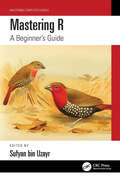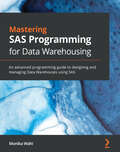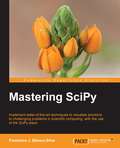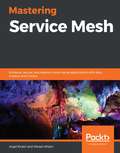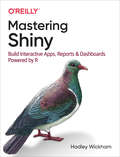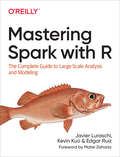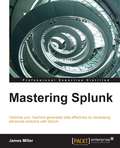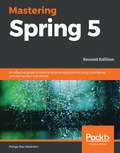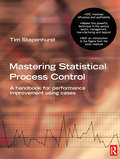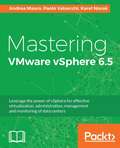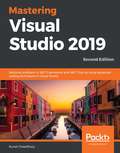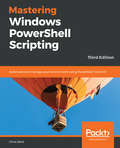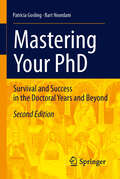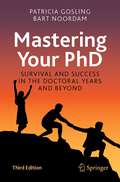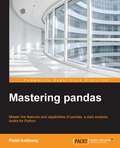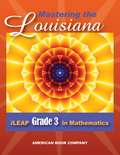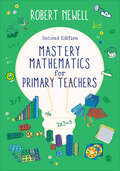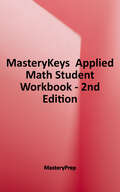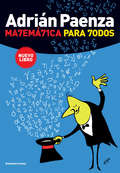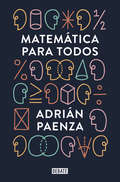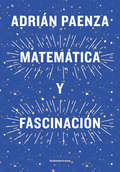- Table View
- List View
Mastering R: A Beginner's Guide (Mastering Computer Science)
by Sufyan Bin UzayrR is a statistical computing and graphics programming language that you can use to clean, analyze, and graph data. It is widely used by researchers from various disciplines to estimate and display results and by teachers of statistics and research methods. This book is a detailed guide for beginners to understand R with an explanation of core statistical and research ideas. One of the powerful characteristics of R is that it is open-source, which means that anyone can access the underlying code used to run the program and add their own code for free. It will always be able to perform the latest statistical analyses as soon as anyone thinks of them. R corrects mistakes quickly and transparently and has put together a community of programming and statistical experts that you can turn to for help. Mastering R: A Beginner’s Guide not only explains how to program but also how to use R for visualization and modeling. The fundamental principles of R explained here are helpful to beginner and intermediate users interested in learning this highly technological and diverse language.
Mastering SAS Programming
by Monika WahiThis book is for managers leading data projects, and programmers or developers using SAS who want to effectively maintain a data lake, data mart, or data warehouse.
Mastering SAS Programming for Data Warehousing: An advanced programming guide to designing and managing Data Warehouses using SAS
by Monika WahiBuild a strong foundation in SAS data warehousing by understanding data transformation code and policy, data stewardship and management, interconnectivity between SAS and other warehousing products, and print and web reportingKey FeaturesUnderstand how to use SAS macros for standardizing extract, transform, and load (ETL) protocolsDevelop and use data curation files for effective warehouse managementLearn how to develop and manage ETL, policies, and print and web reports that meet user needsBook DescriptionSAS is used for various functions in the development and maintenance of data warehouses, thanks to its reputation of being able to handle ’big data’. This book will help you learn the pros and cons of storing data in SAS. As you progress, you’ll understand how to document and design extract-transform-load (ETL) protocols for SAS processes. Later, you’ll focus on how the use of SAS arrays and macros can help standardize ETL. The book will also help you examine approaches for serving up data using SAS and explore how connecting SAS to other systems can enhance the data warehouse user’s experience. By the end of this data management book, you will have a fundamental understanding of the roles SAS can play in a warehouse environment, and be able to choose wisely when designing your data warehousing processes involving SAS.What you will learnDevelop efficient ways to manage data input/output (I/O) in SASCreate and manage extract, transform, and load (ETL) code in SASStandardize ETL through macro variables, macros, and arraysIdentify data warehouse users and ensure their needs are metDesign crosswalk and other variables to serve analyst needsMaintain data curation files to improve communication and managementUse the output delivery system (ODS) for print and web reportingConnect other products to SAS to optimize storage and reportingWho this book is forThis book is for data architects, managers leading data projects, and programmers or developers using SAS who want to effectively maintain a data lake, data mart, or data warehouse.
Mastering SciPy
by Francisco J. Blanco-SilvaImplement state-of-the-art techniques to visualize solutions to challenging problems in scientific computing, with the use of the SciPy stackAbout This BookMaster the theory and algorithms behind numerical recipes and how they can be applied to real-world problemsLearn to combine the most appropriate built-in functions from the SciPy stack by understanding the connection between the sources of your problem, volume of data, or computer architectureA comprehensive coverage of all the mathematical techniques needed to solve the presented topics, with a discussion of the relevant algorithms built in the SciPy stackWho This Book Is ForIf you are a mathematician, engineer, or computer scientist with a proficiency in Python and familiarity with IPython, this is the book for you. Some basic knowledge of numerical methods in scientific computing would be helpful.What You Will LearnMaster relevant algorithms used in symbolic or numerical mathematics to address approximation, interpolation, differentiation, integration, root-finding, and optimization of scalar or multi-variate functionsDevelop different algorithms and strategies to efficiently store and manipulate large matrices of data, in particular to solve systems of linear equations, or compute their eigenvalues/eigenvectorsUnderstand how to model physical problems with systems of differential equations and distinguish the factors that dictate the strategies to solve themPerform statistical analysis, hypothesis test design and resolution, or data mining at a higher level, and apply them to real-life problems in the field of data analysisGain insights on the power of distances, Delaunay triangulations and Voronoi diagrams for Computational Geometry, and apply them to various engineering problemsFamiliarize yourself with different techniques in signal/image processing, including filtering audio, images, or video to extract information, features, or remove componentsIn DetailThe SciPy stack is a collection of open source libraries of the powerful scripting language Python, together with its interactive shells. This environment offers a cutting-edge platform for numerical computation, programming, visualization and publishing, and is used by some of the world's leading mathematicians, scientists, and engineers. It works on any operating system that supports Python and is very easy to install, and completely free of charge! It can effectively transform into a data-processing and system-prototyping environment, directly rivalling MATLAB and Octave.This book goes beyond a mere description of the different built-in functions coded in the libraries from the SciPy stack. It presents you with a solid mathematical and computational background to help you identify the right tools for each problem in scientific computing and visualization. You will gain an insight into the best practices with numerical methods depending on the amount or type of data, properties of the mathematical tools employed, or computer architecture, among other factors.The book kicks off with a concise exploration of the basics of numerical linear algebra and graph theory for the treatment of problems that handle large data sets or matrices. In the subsequent chapters, you will delve into the depths of algorithms in symbolic algebra and numerical analysis to address modeling/simulation of various real-world problems with functions (through interpolation, approximation, or creation of systems of differential equations), and extract their representing features (zeros, extrema, integration or differentiation).Lastly, you will move on to advanced concepts of data analysis, image/signal processing, and computational geometry.Style and approachPacked with real-world examples, this book explores the mathematical techniques needed to solve the presented topics, and focuses on the algorithms built in the SciPy stack.
Mastering Service Mesh: Enhance, secure, and observe cloud-native applications with Istio, Linkerd, and Consul
by Anjali Khatri Vikram Khatri Dinesh Nirmal Hamid Pirahesh Eric HernessUnderstand how to use service mesh architecture to efficiently manage and safeguard microservices-based applications with the help of examples Key Features Manage your cloud-native applications easily using service mesh architecture Learn about Istio, Linkerd, and Consul – the three primary open source service mesh providers Explore tips, techniques, and best practices for building secure, high-performance microservices Book Description Although microservices-based applications support DevOps and continuous delivery, they can also add to the complexity of testing and observability. The implementation of a service mesh architecture, however, allows you to secure, manage, and scale your microservices more efficiently. With the help of practical examples, this book demonstrates how to install, configure, and deploy an efficient service mesh for microservices in a Kubernetes environment. You'll get started with a hands-on introduction to the concepts of cloud-native application management and service mesh architecture, before learning how to build your own Kubernetes environment. While exploring later chapters, you'll get to grips with the three major service mesh providers: Istio, Linkerd, and Consul. You'll be able to identify their specific functionalities, from traffic management, security, and certificate authority through to sidecar injections and observability. By the end of this book, you will have developed the skills you need to effectively manage modern microservices-based applications. What you will learn Compare the functionalities of Istio, Linkerd, and Consul Become well-versed with service mesh control and data plane concepts Understand service mesh architecture with the help of hands-on examples Work through hands-on exercises in traffic management, security, policy, and observability Set up secure communication for microservices using a service mesh Explore service mesh features such as traffic management, service discovery, and resiliency Who this book is for This book is for solution architects and network administrators, as well as DevOps and site reliability engineers who are new to the cloud-native framework. You will also find this book useful if you're looking to build a career in DevOps, particularly in operations. Working knowledge of Kubernetes and building microservices that are cloud-native is necessary to get the most out of this book.
Mastering Shiny
by Hadley WickhamMaster the Shiny web framework—and take your R skills to a whole new level. By letting you move beyond static reports, Shiny helps you create fully interactive web apps for data analyses. Users will be able to jump between datasets, explore different subsets or facets of the data, run models with parameter values of their choosing, customize visualizations, and much more.Hadley Wickham from RStudio shows data scientists, data analysts, statisticians, and scientific researchers with no knowledge of HTML, CSS, or JavaScript how to create rich web apps from R. This in-depth guide provides a learning path that you can follow with confidence, as you go from a Shiny beginner to an expert developer who can write large, complex apps that are maintainable and performant.Get started: Discover how the major pieces of a Shiny app fit togetherPut Shiny in action: Explore Shiny functionality with a focus on code samples, example apps, and useful techniquesMaster reactivity: Go deep into the theory and practice of reactive programming and examine reactive graph componentsApply best practices: Examine useful techniques for making your Shiny apps work well in production
Mastering Spark with R: The Complete Guide to Large-Scale Analysis and Modeling
by Javier Luraschi Kevin Kuo Edgar RuizIf you’re like most R users, you have deep knowledge and love for statistics. But as your organization continues to collect huge amounts of data, adding tools such as Apache Spark makes a lot of sense. With this practical book, data scientists and professionals working with large-scale data applications will learn how to use Spark from R to tackle big data and big compute problems.Authors Javier Luraschi, Kevin Kuo, and Edgar Ruiz show you how to use R with Spark to solve different data analysis problems. This book covers relevant data science topics, cluster computing, and issues that should interest even the most advanced users.Analyze, explore, transform, and visualize data in Apache Spark with RCreate statistical models to extract information and predict outcomes; automate the process in production-ready workflowsPerform analysis and modeling across many machines using distributed computing techniquesUse large-scale data from multiple sources and different formats with ease from within SparkLearn about alternative modeling frameworks for graph processing, geospatial analysis, and genomics at scaleDive into advanced topics including custom transformations, real-time data processing, and creating custom Spark extensions
Mastering Splunk
by James MillerThis book is for those Splunk developers who want to learn advanced strategies to deal with big data from an enterprise architectural perspective. You need to have good working knowledge of Splunk.
Mastering Spring 5: An effective guide to build enterprise applications using Java Spring and Spring Boot framework, 2nd Edition
by Ranga Rao KaranamBuild scalable and flexible Rest APIs and microservices using the latest versions of Spring and Spring Boot Key Features Build Java-based enterprise applications using Spring 5.1 and Spring Boot 2.1 Create high performing, reusable, and scalable enterprise Java applications that are easy to test Gain powerful insights into advanced Spring and Spring Boot concepts to develop applications effectively Book Description Spring 5.1 is the latest release of the widely used Spring Framework. This book takes you through the evolution of building enterprise-ready applications with Spring and Spring Boot. Mastering Spring 5 starts with an overview of some of the important Spring Framework features relating to aspect-oriented programming, task scheduling, and scripting with the help of practical examples. You'll learn about the standard dependency injection specification for Java contexts and CDI and how the Spring Framework supports it. You'll gain an understanding of how application architectures have evolved from monoliths to microservices and be able to build your own microservices using Spring Boot. Complete with real-world examples, this book will help you gain powerful insights into Spring Boot 2.1 and learn how to develop cloud-native microservices with Spring Cloud. You'll even explore how to secure a REST API with Spring Security and get started with your first full stack application using React. Furthermore, you'll get to grips with Kotlin fundamentals and build a Kotlin project in Eclipse. By the end of this book, you'll be equipped with all the knowledge required to develop microservices and full stack applications with the Spring Framework. What you will learn Explore Spring Framework 5.1 features such as AOP, transaction management, task scheduling, and scripting Build REST APIs and microservices with Spring and Spring Boot Develop a secure REST API with Spring Security Build your first full stack React application Write efficient unit tests with Spring and Spring Boot Understand the advanced features that Spring Boot offers to develop and monitor applications Use Spring Cloud to deploy and manage applications on the Cloud Who this book is for This book is for experienced Java and enterprise Java developers and programmers who have a basic understanding of the Spring Framework.
Mastering Statistical Process Control
by Tim StapenhurstMastering Statistical Process Control shows how to understand business or process performance more clearly and more effectively. This practical book is based on a rich and varied selection of case studies from across industry and commerce, including material from the manufacturing, extractive and service sectors. It will enable readers to understand how SPC can be used to maximum effect, and will deliver more effective monitoring, control and improvement in systems, processes and management. The common obstacle to successful use of SPC is getting bogged down with control charts, forgetting that visual representation of data is but a tool and not an end in itself. Mastering SPC demonstrates how statistical tools are applied and used in reality. This is a book that will open up the power of SPC for many: managers, quality professionals, engineers and analysts, as well as students, will welcome the clarity and explanation that it brings to understanding the use and benefit of SPC in a wide range of engineering, production and service situations. Key case studies include using SPC to: · Measure quality and human factors · Monitor process performance accurately over long periods · Develop best-practice benchmarks using control charts · Maximise profitability of fixed assets · Improve customer service and satisfaction
Mastering VMware vSphere 6.5: Leverage The Power Of Vsphere For Effective Virtualization, Administration, Management And Monitoring Of Data Centers
by Andrea Mauro<P><P>Deliver great business value by adopting the virtualization platform VMware vSphere 6.5, from design to deployment <P><P>Key Features <P><P>This new edition is based on vSphere 6.5 and covers new features in different areas, including management, security, scalability, availability and more <P><P>Design, deploy and manage VMware datacenters <P><P>Implement monitoring and security of VMware workloads with ease <P><P>Book Description <P><P>VMware vSphere 6.5 provides a powerful, flexible and secure foundation for next generation applications which helps you create effective digital transformation. This book is based on VMware vSphere 6.5 which empowers you to virtualize complex applications with ease. <P><P>You'll begin by getting an overview of all the products, solutions and features of the vSphere 6.5 suite, comparing any changes with previous releases. Next, you'll design and plan a virtualization infrastructure to drive planning and performance analysis. Following this, you'll proceed with workflow and installation of components. New network trends are also covered which will help you in optimally designing the vSphere environment. You will also learn the practices and procedures involved in configuring and managing virtual machines in a vSphere infrastructure. With vSphere 6.5, you'll make use of significantly more powerful capabilities for patching, upgrading, and managing the configuration of the virtual environment. Next we'll focus on specific availability and resiliency solutions in vSphere. <P><P>Towards the end of the book you'll discover how to save your configuration, data and workload from your virtual infrastructure. By the end of the book you'll have learnt about VMware vSphere 6.5 right from design through to deployment and management. <P><P>What you will learn <P><P>Get a deep understanding of vSphere 6.5 functionalities <P><P>Design and plan a virtualization environment based on vSphere 6.5 <P><P>Manage and administer a vSphere 6.5 environment and resources <P><P>Get tips for the VCP6DCV and VCIX6DCV exams (along with use of the vSphere 6 documentation) <P><P>Implement different migration techniques to move your workload across different environments <P><P>Save your configuration, data and workload from your virtual infrastructure <P><P>Who This Book Is For <P><P>If you're an administrator, infrastructure engineer, IT architect, or an IT consultant and analyst who already has basic knowledge of VMware vSphere and now want to master it, then this book is for you.
Mastering Visual Studio 2019 - Second Edition
by Kunal ChowdhuryMicrosoft .NET Developers who would like to learn the new features of Visual Studio 2019, and would like to delve into newer areas such as cloud computing, .NET Core, TypeScript, along with mastering the skills of building, debugging and unit testing professional apps, would benefit from this book. Basic knowledge of Visual Studio, .NET and C# is assumed.
Mastering Windows PowerShell Scripting: Automate and manage your environment using PowerShell Core 6.0, 3rd Edition
by Chris DentGrasp advanced PowerShell Core 6.0 functionalities to automate your environmentKey FeaturesKeep up with changes introduced in PowerShell Core 6.0Easily maintain appropriate compatibility with older versionsAutomate complex tasks, manipulate data, and secure your environment with PowerShell Core 6.0Book DescriptionPowerShell scripts offer a handy way to automate various chores, however working effectively with these scripts can be a difficult task.This comprehensive guide starts with the fundamentals before moving on to advanced-level topics to help you become a PowerShell Core 6.0 expert. The first module, PowerShell Core 6.0 Fundamentals, begins with the new features of PowerShell Core 6.0, installing it on Linux, and working with parameters, objects and .NET classes from within PowerShell Core 6.0. As you make your way through the chapters, you'll see how to efficiently manage large amounts of data and interact with other services using PowerShell Core 6.0. You'll be able to make the most of PowerShell Core 6.0's powerful automation feature, where you will have different methods available to parse data and manipulate regular expressions and Windows Management Instrumentation (WMI). After having explored automation, you will enter the extending PowerShell Core 6.0 module, covering asynchronous processing and desired state configuration. In the last module, you will learn to extend PowerShell Core 6.0 using advanced scripts and filters, and also debug issues along with working on error handling techniques.By the end of this book, you will be an expert in scripting with PowerShell Core 6.0.What you will learnOptimize code through the use of functions, switches, and looping structuresWork with objects and operators to test and manipulate dataParse and manipulate different data typesCreate scripts and functions using PowerShellUse jobs, events, and popular public modules which assist with implementing multithreadingWrite .NET classes with ease within the PowerShellCreate and implement regular expressions in PowerShell scriptsMake use of advanced techniques to define and restrict the behavior of parametersWho this book is forIf you are a system administrator who wants to become an expert in controlling and automating your Windows environment, then Mastering Windows PowerShell Scripting is for you. It is also ideal for those new to the PowerShell language.
Mastering Your PhD
by Lambertus D. Noordam Patricia Gosling"Mastering Your PhD: Survival and Success in the Doctoral Years and Beyond" helps guide PhD students through their graduate student years. Filled with practical advice on getting started, communicating with your supervisor, staying the course, and planning for the future, this book is a handy guide for graduate students who need that extra bit of help getting started and making it through. While mainly directed at PhD students in the sciences, the book's scope is broad enough to encompass the obstacles and hurdles that almost all PhD students face during their doctoral training. Who should read this book? Students of the physical and life sciences, computer science, math, and medicine who are thinking about entering a PhD program; doctoral students at the beginning of their research; and any graduate student who is feeling frustrated and stuck. It's never too early -- or too late! This second edition contains a variety of new material, including additional chapters on how to communicate better with your supervisor, dealing with difficult people, how to find a mentor, and new chapters on your next career step, once you have your coveted doctoral degree in hand.
Mastering Your PhD: Survival and Success in the Doctoral Years and Beyond
by Patricia Gosling Bart NoordamThis bestselling book guides PhD students through their graduate years and beyond. Filled with practical advice on getting started, communicating with your supervisor, staying the course, and planning for the future, this book is an indispensable guide for graduate students who need that extra bit of help getting started and making it through. Who should read this book? Any student currently in, or curious about, a PhD programme, be it in the physical and life sciences, engineering, computer science, math, medicine, or the humanities — this book tackles the obstacles and hurdles that almost all PhD students face during their doctoral training. Whether you’re at the very beginning of your research, close to the end, or just feeling frustrated and stuck at any point in between…it’s never too early — or too late — to focus on your success! This third edition contains a variety of new material, including additional chapters and advice on how to make the most of remote learning, collaboration, and communication tools, as well as updated material on your next career step once you have your coveted doctoral degree in hand. Some of the material in the third edition appeared as part of a monthly column on the ScienceCareers website.
Mastering pandas
by Femi AnthonyThis book is intended for Python programmers, mathematicians, and analysts who already have a basic understanding of Python and wish to learn about its data analysis capabilities in depth.
Mastering the Louisiana iLEAP Grade 3 in Mathematics
by Erica Day Colleen Pintozzi Mary ReaganMastering the Louisiana iLEAP Grade 3 in Mathematics will help you review and learn important concepts and skills related to 3rd grade mathematics.
Mastery Mathematics for Primary Teachers
by Robert NewellThis book examines how mathematical mastery, influenced by East Asian teaching approaches, can be developed in UK schools to enhance teaching and to deepen children’s mathematical knowledge. It gives guidance on using physical resources to demonstrate key concepts, extended examples on how to teach different curriculum topics and how to plan for small-step progression. It argues that effective mastery teaching requires careful and knowledgeable support for primary teachers who may not yet be maths specialists. New to this second edition: New chapter on variation theory and practice Updated case studies exploring how mastery teaching has evolved Updated review of current mastery resources available to UK teachers Robert Newell is a lecturer at the UCL Institute of Education, London.
Mastery Mathematics for Primary Teachers
by Robert NewellThis book examines how mathematical mastery, influenced by East Asian teaching approaches, can be developed in UK schools to enhance teaching and to deepen children’s mathematical knowledge. It gives guidance on using physical resources to demonstrate key concepts, extended examples on how to teach different curriculum topics and how to plan for small-step progression. It argues that effective mastery teaching requires careful and knowledgeable support for primary teachers who may not yet be maths specialists. New to this second edition: New chapter on variation theory and practice Updated case studies exploring how mastery teaching has evolved Updated review of current mastery resources available to UK teachers Robert Newell is a lecturer at the UCL Institute of Education, London.
MasteryKeys: Applied Math Student Workbook
by MasteryPrepFrom this book you will learn addition, subtraction, multiplication, and division. You will learn how to convert numbers between fractions, decimals, and percentages. Lastly, you will learn how to solve problems dealing with negative numbers, money, and time.
Matemática para todos
by Adrián PaenzaEl padre de la matemática recreativa en la Argentina nos desafía con másjuegos, problemas y enigmas. Con problemas de lógica, estrategia, probabilidades e intuición, AdriánPaenza nos desafía una vez más a pensar y animarnos a jugar a lamatemágica. Como dijo Richard Hamming: «Conocimiento y productividad soncomo el interés compuesto. Dadas dos personas con -aproximadamente- lamisma habilidad, si una de ellas trabaja un diez por ciento más que laotra, la que trabaja más va a terminar por producir más del doble que laotra. Cuanto más sabés, más aprendés. Cuanto más aprendés, más podéshacer. Cuanto más podés hacer, más oportunidades vas a tener. Funcionacomo el interés compuesto. No quiero dar un número porque no es algoexacto, pero dadas dos personas con la misma habilidad, la persona quepueda dedicarle todos los días una hora más a pensar que la otra, va aterminar siendo muchísimo más productiva en comparación a lo largo de lavida». Pensar, nos educa. «Matemática para todos» es el nuevo aporte deAdrián Paenza a la divulgación de la matemática.
Matemática para todos
by Adrián PaenzaAdrián Paenza, ganador del premio Leelavati al mejor divulgador de matemáticas del mundo y autor de exitosos títulos como Matemagia o ¿Pero esto también es matemática? , nos desafía una vez más a pensar con nuevos problemas de lógica, estrategia, probabilidades e intuición. Como dijo Richard Hamming: «Conocimiento y productividad son como el interés compuesto. Dadas dos personas con -aproximadamente- la misma habilidad, si una de ellas trabaja un diez por ciento más que la otra, la que trabaja más va a terminar por producir más del doble que la otra. Cuanto más sabes, más aprendes. Cuanto más aprendes, más puedes hacer. Cuanto más puedes hacer, más oportunidades vas a tener. Funciona como el interés compuesto. No quiero dar un número porque no es algo exacto, pero dadas dos personas con la misma habilidad, la persona que pueda dedicarle todos los días una hora más a pensar que la otra, va a terminar siendo muchísimo más productiva en comparación a lo largo de la vida». Pensar nos educa y Matemática para todos es el nuevo aporte de Adrián Paenza a la divulgación de las matemáticas.
Matemática y fascinación
by Adrián PaenzaAdrián Paenza nos invita a bajar un cambio y pasar un tiempo con nosotros mismos para hacer matemática como los matemáticos. La matemática está presente todos los días en cada momento de nuestras vidas y hasta nos sirve para tomar decisiones difíciles. Pero también es capaz de jugar con nuestra curiosidad para sorprendernos y fascinarnos como cuando éramos niños. Baje un cambio y disfrute de este libro: conozca los números narcisistas y resuelva problemas tendenciosos. Descubra un mensaje encriptado. Cuente con los dedos de las dos manos hasta mucho más de mil. Atrévase a presentar a su familia o amigos un pase de magia. Diviértase con el póquer de la vida real. Deje que se le ponga la piel de gallina con la extraordinaria historia de las hermanas ajedrecistas... En fin, haga matemática como los matemáticos. Anímese a pasar un tiempo con usted mismo para desafiarse. ¡Vale la pena!
